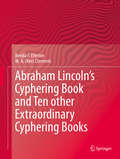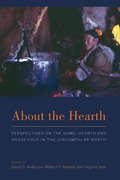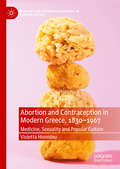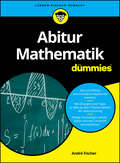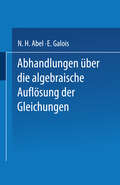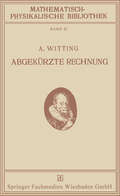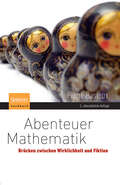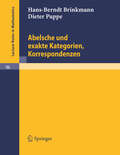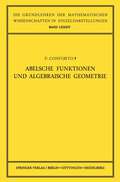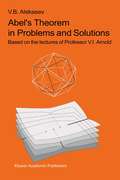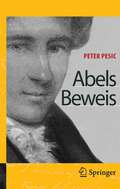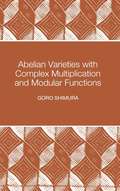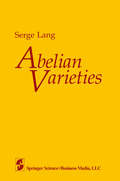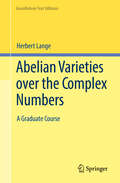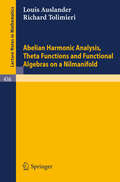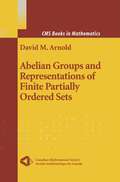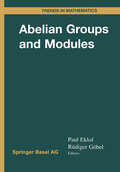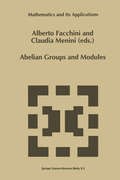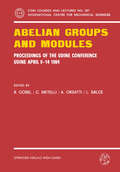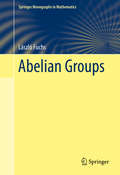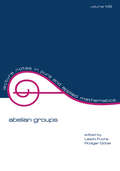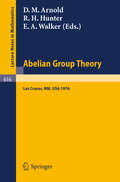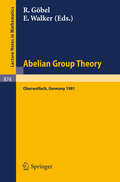- Table View
- List View
Abraham Lincoln’s Cyphering Book and Ten other Extraordinary Cyphering Books
by Nerida F. Ellerton M. A. ClementsThis well-illustrated book provides strong qualitative and comparative support for the main arguments developed by Nerida Ellerton and Ken Clements in their groundbreaking Rewriting this History of School Mathematics in North America 1607–1861: The Central Role of Cyphering Books. Eleven extraordinary handwritten school mathematics manuscripts are carefully analyzed—six were prepared entirely in Great Britain, four entirely in North America, and 1 partly in Great Britain and partly in North America. The earliest of the 11 cyphering books was prepared around 1630, and the latest in 1835. Seven of the manuscripts were arithmetic cyphering books; three were navigation cyphering books, and one was a mensuration/surveying manuscript.One of the cyphering books examined in this book was prepared, over the period 1819–1826, by a young Abraham Lincoln, when he was attending small one-teacher schools in remote Spencer County, Indiana. Chapter 6 in this book provides the first detailed analysis of young Abraham’s cyphering book—which is easily the oldest surviving Lincoln manuscript. Another cyphering book, this one prepared by William Beattie in 1835, could have been prepared as a special gift for the King of England. The analyses make clear the extent of the control which the cyphering tradition had over school mathematics in North America and Great Britain between 1630 and 1840.In their final chapter Ellerton and Clements identify six lessons from their research into the cyphering tradition which relate to present-day circumstances surrounding school mathematics. These lessons are concerned with sharp differences between intended, implemented and attained curricula, the remarkable value that many students placed upon their cyphering books, the ethnomathematical circumstances which surrounded the preparations of the extraordinary cyphering books, and qualitative differences between British and North American school mathematics.
About the Hearth: Perspectives on the Home, Hearth and Household in the Circumpolar North
by David G. Anderson Robert P. Wishart Virginie VatéDue to changing climates and demographics, questions of policy in the circumpolar north have focused attention on the very structures that people call home. Dwellings lie at the heart of many forms of negotiation. Based on years of in-depth research, this book presents and analyzes how the people of the circumpolar regions conceive, build, memorialize, and live in their dwellings. This book seeks to set a new standard for interdisciplinary work within the humanities and social sciences and includes anthropological work on vernacular architecture, environmental anthropology, household archaeology and demographics.
Abortion and Contraception in Modern Greece, 1830-1967: Medicine, Sexuality and Popular Culture (Medicine and Biomedical Sciences in Modern History)
by Violetta HionidouThe book examines the history of abortion and contraception in Modern Greece from the time of its creation in the 1830s to 1967, soon after the Pill became available. It situates the history of abortion and contraception within the historiography of the fertility decline and the question of whether the decline was due to adjustment to changing social conditions or innovation of contraceptive methods. The study reveals that all methods had been in use for other purposes before they were employed as contraceptives. For example, Greek women were employing emmenagogues well before fertility was controlled; they did so in order to ‘put themselves right’ and to enhance their fertility. When they needed to control their fertility, they employed abortifacients, some of which were also emmenagogues, while others had been used as expellants in earlier times. Curettage was also employed since the late nineteenth century as a cure for sterility; once couples desired to control their fertility curettage was employed to procure abortion. Thus couples did not need to innovate but rather had to repurpose old methods and materials to new birth control methods. Furthermore, the role of physicians was found to have been central in advising and encouraging the use of birth control for ‘health’ reasons, thus facilitating and speeding fertility decline in Greece. All this occurred against the backdrop of a state and a church that were at times neutral and at other times disapproving of fertility control.
Abitur Mathematik für Dummies (Für Dummies)
by André FischerSo klappt es mit dem Mathe-Abi Nutzen Sie die Zeit bis zu Ihrer Abiturprüfung im Fach Mathematik und bereiten Sie sich mit diesem Buch vor, um die Prüfung so gut wie möglich zu bestehen. Egal, wie gut der geforderte Lernstoff fürs Abi bereits sitzt: André Fischer erklärt Ihnen in einfachen und verständlichen Worten, was Sie über Analysis, Vektorgeometrie, lineare Algebra und Stochastik wissen müssen. Grundlegender Schulstoff wird dabei so wiederholt, dass Sie einfach folgen können. Beispielrechnungen veranschaulichen die Erklärungen und mit den enthaltenen Übungsaufgaben können Sie Ihr Wissen festigen. Sie erfahren Welche mathematischen Grundlagen unerlässlich sind Was es mit Kurven-diskussionen, linearen Gleichungssystemen und Zufallsvariablen auf sich hat Was Sie bei der Prüfungs-vorbereitung beachten sollten
Abiogenesis: The Physical Basis for Living Systems
by Laurel O. SillerudThis textbook serves to teach readers about the origins of life, the probabilistic process of self-assembly underpinning all living systems, from a biophysics perspective. The author cohesively summarizes the various organizing principles that led to the development of an ordered physical basis on which the evolution of life operates. This book answers critical questions, such as why life depends on the properties of inanimate objects and how the laws of physics, chemistry, and biology convolved to spontaneously produce the periodic table and, of course, life itself. Readers are provided with an introduction to probability distributions as well as detailed descriptions of important concepts in thermodynamics, statistical mechanics, and quantum mechanics. As the book progresses, an understanding for the inevitability of life is developed through topics such as stellar nucleosynthesis and prebiotic evolution. Each chapter also includes problems for readers to gain a better understanding of the material. This textbook is accessible to students and researchers of all levels and serves as a comprehensive guide on the physics behind abiogenesis.
Abgekürzte Rechnung: Nebst Einer Einführung in die Rechnung mit Logarithmen (Mathematisch-physikalische Bibliothek)
by Alexander WittingDieser Buchtitel ist Teil des Digitalisierungsprojekts Springer Book Archives mit Publikationen, die seit den Anfängen des Verlags von 1842 erschienen sind. Der Verlag stellt mit diesem Archiv Quellen für die historische wie auch die disziplingeschichtliche Forschung zur Verfügung, die jeweils im historischen Kontext betrachtet werden müssen. Dieser Titel erschien in der Zeit vor 1945 und wird daher in seiner zeittypischen politisch-ideologischen Ausrichtung vom Verlag nicht beworben.
Abenteuer Mathematik: Brücken zwischen Wirklichkeit und Fiktion
by Pierre BasieuxNicht Mathematik zu betreiben, sondern zu erfahren ist das Abenteuer, das dieses Buch bietet – Denkexpeditionen, deren Ausgangspunkt Fragen sind: Was steckt hinter mathematischen Fiktionen wie den unendlich vielen Stufen des Unendlichen oder dem Letzten Fermatschen Satz? Worin liegt ihre Schönheit, worin ihr Bezug zur Realität? Welchen Köpfen sind solche Ideen entsprungen, welche Schicksale mit ihnen verbunden? Das Buch wurde für die vorliegende 5. Auflage vollständig durchgesehen und aktualisiert.
Abelsche und exakte Kategorien, Korrespondenzen (Lecture Notes in Mathematics #96)
by Hans-Berndt Brinkmann Dieter PuppeAbelsche Funktionen und Algebraische Geometrie (Grundlehren der mathematischen Wissenschaften #84)
by Fabio ConfortoAbel’s Theorem in Problems and Solutions: Based on the lectures of Professor V.I. Arnold
by V.B. AlekseevDo formulas exist for the solution to algebraical equations in one variable of any degree like the formulas for quadratic equations? The main aim of this book is to give new geometrical proof of Abel's theorem, as proposed by Professor V.I. Arnold. The theorem states that for general algebraical equations of a degree higher than 4, there are no formulas representing roots of these equations in terms of coefficients with only arithmetic operations and radicals. A secondary, and more important aim of this book, is to acquaint the reader with two very important branches of modern mathematics: group theory and theory of functions of a complex variable. This book also has the added bonus of an extensive appendix devoted to the differential Galois theory, written by Professor A.G. Khovanskii. As this text has been written assuming no specialist prior knowledge and is composed of definitions, examples, problems and solutions, it is suitable for self-study or teaching students of mathematics, from high school to graduate.
Abels Beweis
by Peter PesicAus den Rezensionen zur englischen Auflage: "Die Leser von Pesics faszinierendem kleinen Buch werden zu dem unausweichlichen Urteil kommen: Niels [Henrik] Abel hat sich der Genialität im fünften Grade schuldig gemacht." William Dunham, Muhlenberg College und Autor von "Journey through Genius: The Great Theorems of Mathematics "Peter Pesic schreibt über Abels Werk mit Begeisterung und Einfühlungsvermögen, und ruft Erinnerungen an die großartigen Momente in der Entwicklung der Algebra wach." Barry Mazur, Gerhard Gade University Professor, Harvard University "Ein einzigartiges Buch. Peter Pesics Chronik des langen Weges der Mathematiker zum Verständnis, wann eine Gleichung gelöst werden kann - und wann nicht - ist amüsant, einleuchtend und leserfreundlich. Der Autor bemüht sich sehr, auch weniger bekannte Namen wie Viète und Ruffini gebührend zu würdigen und verlangt von seinen Lesern nicht mehr als Basiswissen in der Algebra - wovon ein Großteil angenehmerweise getrennt vom Haupttext plaziert wurde." Tony Rothman, Department of Physics, Bryn Mawr College "Peter Pesics Geschichte über die Entstehung der Mathematik ist genauso spannend wie ein Roman." Economist
Abelian Varieties with Complex Multiplication and Modular Functions (PDF)
by Goro ShimuraReciprocity laws of various kinds play a central role in number theory. In the easiest case, one obtains a transparent formulation by means of roots of unity, which are special values of exponential functions. A similar theory can be developed for special values of elliptic or elliptic modular functions, and is called complex multiplication of such functions. In 1900 Hilbert proposed the generalization of these as the twelfth of his famous problems. In this book, Goro Shimura provides the most comprehensive generalizations of this type by stating several reciprocity laws in terms of abelian varieties, theta functions, and modular functions of several variables, including Siegel modular functions. This subject is closely connected with the zeta function of an abelian variety, which is also covered as a main theme in the book. The third topic explored by Shimura is the various algebraic relations among the periods of abelian integrals. The investigation of such algebraicity is relatively new, but has attracted the interest of increasingly many researchers. Many of the topics discussed in this book have not been covered before. In particular, this is the first book in which the topics of various algebraic relations among the periods of abelian integrals, as well as the special values of theta and Siegel modular functions, are treated extensively.
Abelian Varieties over the Complex Numbers: A Graduate Course (Grundlehren Text Editions)
by Herbert LangeThis textbook offers an introduction to abelian varieties, a rich topic of central importance to algebraic geometry. The emphasis is on geometric constructions over the complex numbers, notably the construction of important classes of abelian varieties and their algebraic cycles.The book begins with complex tori and their line bundles (theta functions), naturally leading to the definition of abelian varieties. After establishing basic properties, the moduli space of abelian varieties is introduced and studied. The next chapters are devoted to the study of the main examples of abelian varieties: Jacobian varieties, abelian surfaces, Albanese and Picard varieties, Prym varieties, and intermediate Jacobians. Subsequently, the Fourier–Mukai transform is introduced and applied to the study of sheaves, and results on Chow groups and the Hodge conjecture are obtained.This book is suitable for use as the main text for a first course on abelian varieties, for instance as a second graduate course in algebraic geometry. The variety of topics and abundant exercises also make it well suited to reading courses. The book provides an accessible reference, not only for students specializing in algebraic geometry but also in related subjects such as number theory, cryptography, mathematical physics, and integrable systems.
Abelian Harmonic Analysis, Theta Functions and Functional Algebras on a Nilmanifold (Lecture Notes in Mathematics #436)
by L. Auslander R. TolimieriAbelian Groups and Representations of Finite Partially Ordered Sets (CMS Books in Mathematics)
by David ArnoldThe theme of this book is an exposition of connections between representations of finite partially ordered sets and abelian groups. Emphasis is placed throughout on classification, a description of the objects up to isomorphism, and computation of representation type, a measure of when classification is feasible. David M. Arnold is the Ralph and Jean Storm Professor of Mathematics at Baylor University. He is the author of "Finite Rank Torsion Free Abelian Groups and Rings" published in the Springer-Verlag Lecture Notes in Mathematics series, a co-editor for two volumes of conference proceedings, and the author of numerous articles in mathematical research journals.
Abelian Groups and Modules: International Conference in Dublin, August 10–14, 1998 (Trends in Mathematics)
by Paul C. Eklof Rüdiger GöbelA 30-article volume, introducing an active and attractive part of algebra that has gained much from its position at the crossroads of mathematics over the years. The papers stimulate the reader to consider and actively investigate the topics and problems they contain.
Abelian Groups and Modules: Proceedings of the Padova Conference, Padova, Italy, June 23–July 1, 1994 (Mathematics and Its Applications #343)
by Alberto Facchini Claudia MeniniOn the 26th of November 1992 the organizing committee gathered together, at Luigi Salce's invitation, for the first time. The tradition of abelian groups and modules Italian conferences (Rome 77, Udine 85, Bressanone 90) needed to be kept up by one more meeting. Since that first time it was clear to us that our goal was not so easy. In fact the main intended topics of abelian groups, modules over commutative rings and non commutative rings have become so specialized in the last years that it looked really ambitious to fit them into only one meeting. Anyway, since everyone of us shared the same mathematical roots, we did want to emphasize a common link. So we elaborated the long symposium schedule: three days of abelian groups and three days of modules over non commutative rings with a two days' bridge of commutative algebra in between. Many of the most famous names in these fields took part to the meeting. Over 140 participants, both attending and contributing the 18 Main Lectures and 64 Communications (see list on page xv) provided a really wide audience for an Algebra meeting. Now that the meeting is over, we can say that our initial feeling was right.
Abelian Groups and Modules: Proceedings of the Udine Conference, Udine, April 9-14, 1984. Dedicated to Laszlo Fuchs on his 60th Birthday (CISM International Centre for Mechanical Sciences #287)
by R. Göbel C. Metelli A Orsatti L. SalceAbelian Groups (Springer Monographs in Mathematics)
by László FuchsWritten by one of the subject’s foremost experts, this book focuses on the central developments and modern methods of the advanced theory of abelian groups, while remaining accessible, as an introduction and reference, to the non-specialist. It provides a coherent source for results scattered throughout the research literature with lots of new proofs.The presentation highlights major trends that have radically changed the modern character of the subject, in particular, the use of homological methods in the structure theory of various classes of abelian groups, and the use of advanced set-theoretical methods in the study of un decidability problems. The treatment of the latter trend includes Shelah’s seminal work on the un decidability in ZFC of Whitehead’s Problem; while the treatment of the former trend includes an extensive (but non-exhaustive) study of p-groups, torsion-free groups, mixed groups and important classes of groups arising from ring theory. To prepare the reader to tackle these topics, the book reviews the fundamentals of abelian group theory and provides some background material from category theory, set theory, topology and homological algebra.An abundance of exercises are included to test the reader’s comprehension, and to explore noteworthy extensions and related sidelines of the main topics. A list of open problems and questions, in each chapter, invite the reader to take an active part in the subject’s further development.
Abelian Groups
by Laszlo FuchsThis volume contains information offered at the international conference held in Curacao, Netherlands Antilles. It presents the latest developments in the most active areas of abelian groups, particularly in torsion-free abelian groups.;For both researchers and graduate students, it reflects the current status of abelian group theory.;Abelian Groups discusses: finite rank Butler groups; almost completely decomposable groups; Butler groups of infinite rank; equivalence theorems for torsion-free groups; cotorsion groups; endomorphism algebras; and interactions of set theory and abelian groups.;This volume contains contributions from international experts. It is aimed at algebraists and logicians, research mathematicians, and advanced graduate students in these disciplines.
Abelian Groups
by Laszlo Fuchs Rüdiger GöbelThis volume contains information offered at the international conference held in Curacao, Netherlands Antilles. It presents the latest developments in the most active areas of abelian groups, particularly in torsion-free abelian groups.;For both researchers and graduate students, it reflects the current status of abelian group theory.;Abelian Groups discusses: finite rank Butler groups; almost completely decomposable groups; Butler groups of infinite rank; equivalence theorems for torsion-free groups; cotorsion groups; endomorphism algebras; and interactions of set theory and abelian groups.;This volume contains contributions from international experts. It is aimed at algebraists and logicians, research mathematicians, and advanced graduate students in these disciplines.
